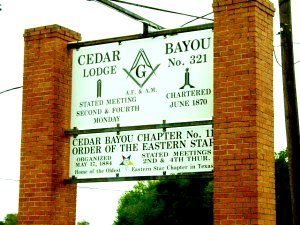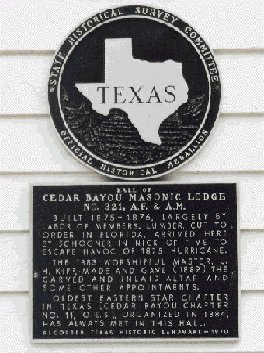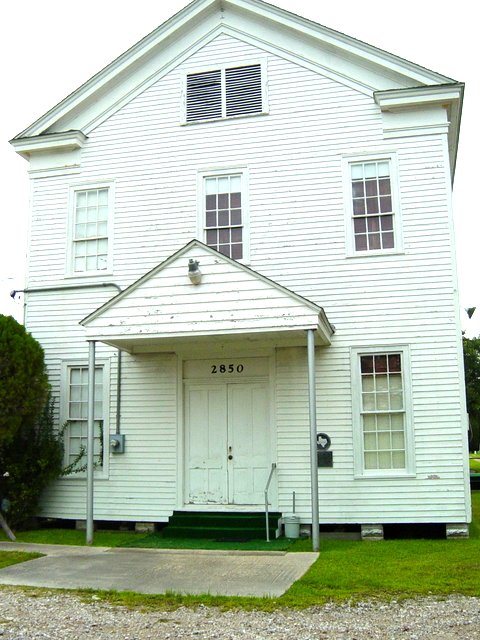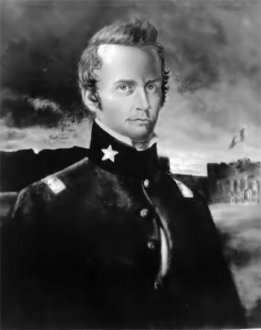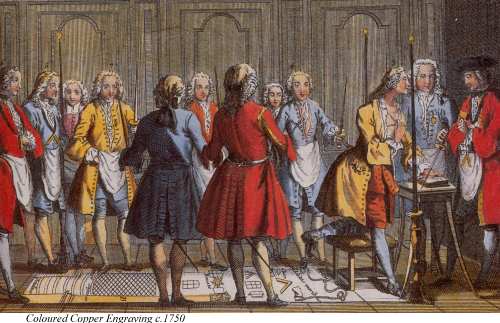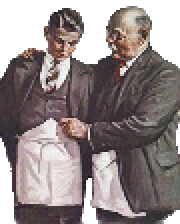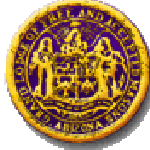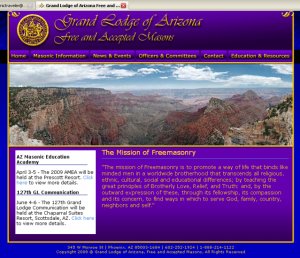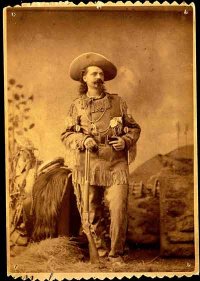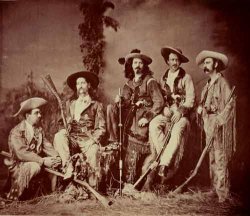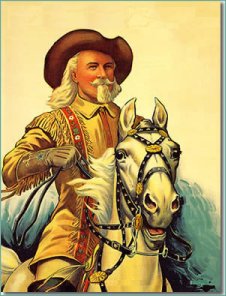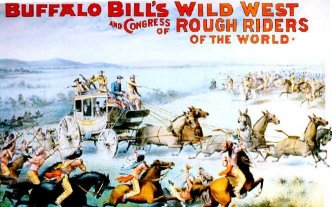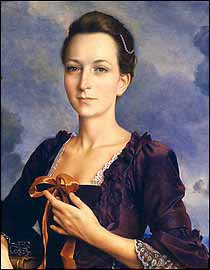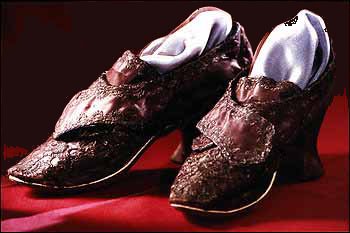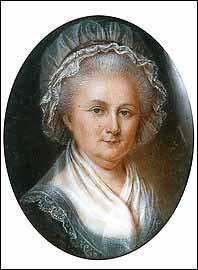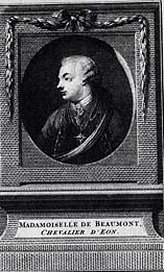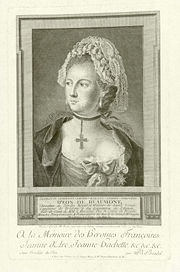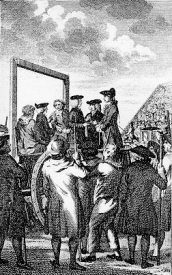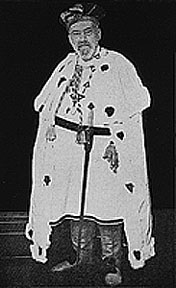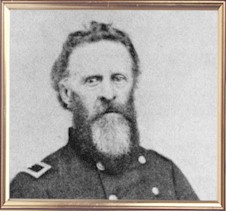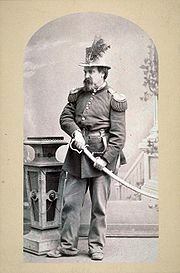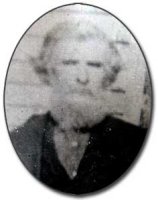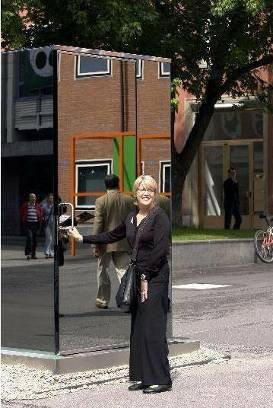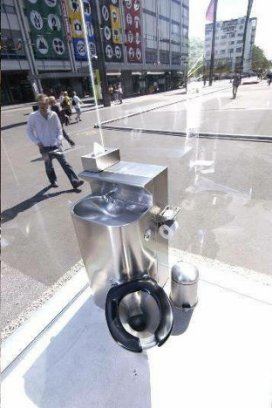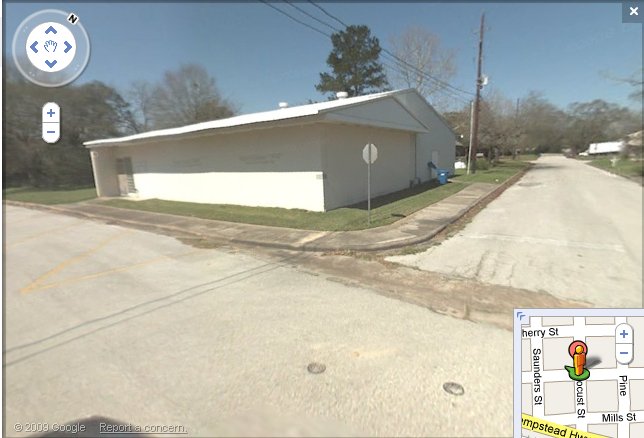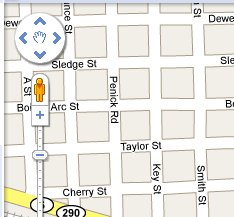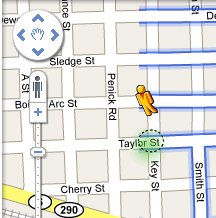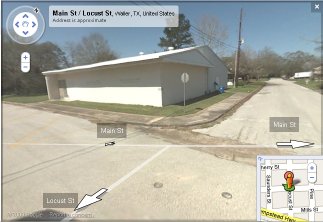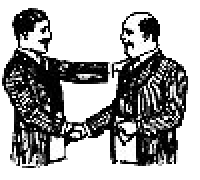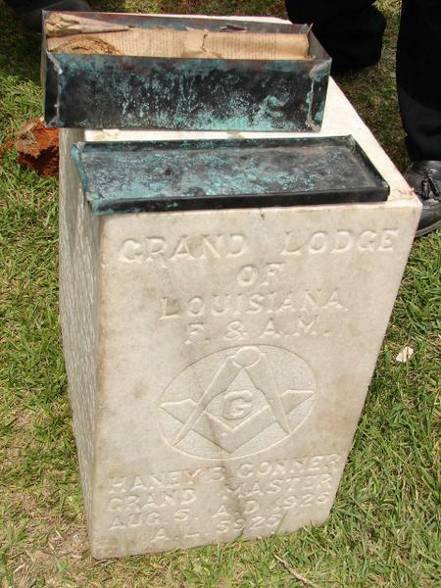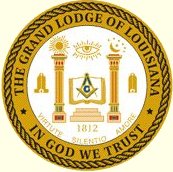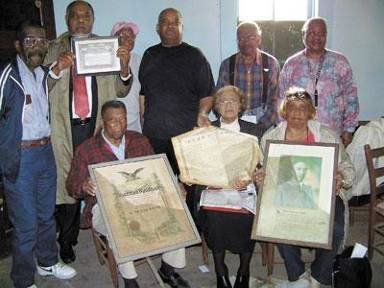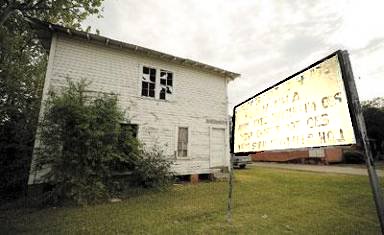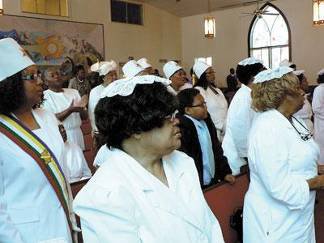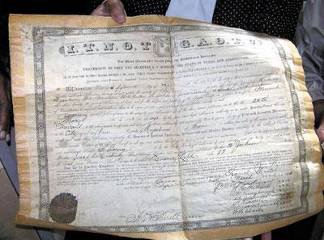
|
July 2009

The Cedar Bayou Masonic Lodge
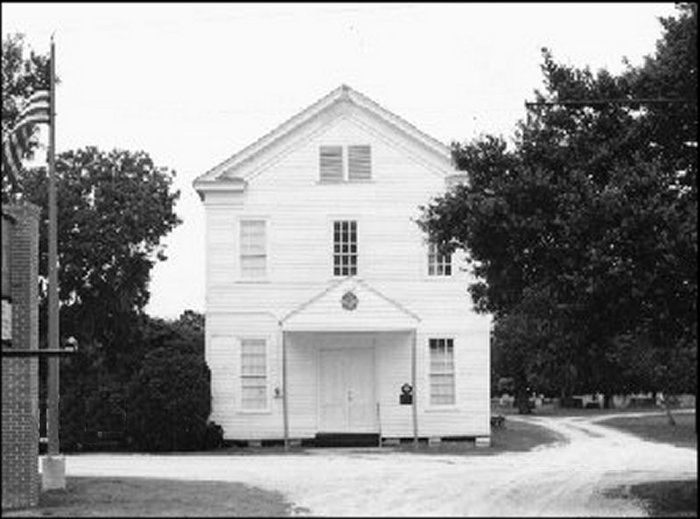 The Cedar Bayou Masonic Lodge No. 3211 AF & AM - Built 1875/6 |
|
Page III | |
|
#321 A.F. & A.M.
In early days all of Harris County east from the City of Houston, and the whole of Chambers County, was under the Masonic jurisdiction of Sampson Lodge, No. 231. Sampson Lodge was then located at Lynchburg, at that time a thriving town, and the shipping point for most of the cotton raised east of the San Jacinto River. The old settlements were far apart, with no roads except the wide prairies between them and with many deep bayous and creeks to cross, all without bridges, and with very few ferries. For many of the old settlers, even in dry seasons, to reach Lynchburg was a hard day's journey. In wet .seasons the journey was almost impossible. But Lynchburg was the only place where a Masonic Lodge could live and thrive, because of the population of the town, and the nearness of some of the older settlements. But some of the members of the Lodge lived as far as thirty miles away. However, in the late '1860s, Cedar Bayou began to grow to some importance. On account of its brick manufacturing plants the population had doubled and trebled in a few years. Some of the newcomers were Masons, and these, with some of the Brethren who were members of Sampson Lodge, but lived at a distance from Lynchburg, soon united, and applied to the Grand Lodge for a charter to establish a Lodge at Cedar Bayou.
The application to the Grand Lodge for the charter having been acted upon favorably, and a dispensation granted, Cedar Bayou Lodge, U. D., met in the upper story of the new building on May 15, 1870. The ground dimensions of the first home of Cedar Bayou Lodge were about fifteen feet by thirty feet. The walls were built box fashion, of rough lumber, with battens to cover the cracks. The gables of the building faced north and south. On the north end was an open stairway that led up to the Lodge room. Up this stairway, after having been prepared in the church below, the first candidates were conducted, and when an old-fashioned sleety norther was blowing it was not an altogether pleasant journey. The Lodge room itself, in the beginning, was a bare room with naked walls, and an uncovered floor made from rough lumber. The stands at the stations were home-made, and far from artistic in design. The Altar was a dry goods box, draped in brown cloth, and the chairs were benches without backs. To the best recollection of this historian, the room had only two windows, both in the west wall. The building being situated as it was — north and south — it became necessary to move the stations eight points around the compass to allow for proper working conditions. Thus, the East was in the south, the South in the west, and the West in the north. The only improvement made in the Lodge room during the first year was to curtain off the north end of the hall for an antechamber. After that, as finances allowed, improvements were made gradually. The floor was covered with some sort of matting, the walls were papered, the room was ceiled overhead, and a wall of lumber partitioned off the antechamber. But this writer remembers that nearly two years after the house was built, when he happened to be in a rather recumbent position in the Lodge room, and chanced to look upward, he could see through the cracks between the clapboards how the stars were twinkling in the April sky. The way to go anywhere in those early days was to ride horseback. The horses were wiry little prairie ponies, the larger number of them either notch-eared or hipshot. Only one or two of the members lived near enough to the Lodge to go there on foot. Those living on the east side of the bayou had the wide prairie for a road, with only a few deep miry gullies to cross, but those living on the west side must cross the bayou. The meeting time of the Lodge was about the middle of the afternoon, "Saturday on or before the full moon." The Brethren who would have to cross the bayou usually gathered at Ilfrey's store, and would cross together, helping each other with the horses, some of which would go onto the flatboat used for a ferry, while the others, more wild, had to be towed across, swimming. This little cavalcade, at first, if work was anticipated, always provided itself with a lunch sufficient for all the members, to be eaten at some suitable time during the night. This lunch consisted mostly of crackers and sardines, and was washed down later with copious draughts of bayou water. Later on, however, an arrangement was made with Bro. John Harrell, who lived just across the bayou from the Lodge, to furnish refreshments, and some time between dark and midnight he would bring over a huge basketful of sandwiches, and a large pot of steaming coffee. And, what a feast! No modern banquet can furnish anything to equal its deliciousness. The Charter, dated June 18, 1970, having been received, the first stated meeting was held on July 9, when the officers of the Lodge were installed, and the first degrees conferred. At the stated meeting of the Lodge on December 3, it being the meeting just preceding the day of St. John the Evangelist, the first regular election of officers was held, and Bro. H. F. Gillette was again elected Worshipful Master. As early as at a meeting of the Lodge in April, 1871, the question of a new location for a Masonic building was brought up, and a committee was appointed to make a selection. In June the committee reported that they had selected the lot on which the present Lodge building stands. No action on the report is stated in the minutes of that date, but at the next meeting of the Lodge the committee is reported being discharged. It was not alone the inconvenient location of the Lodge at that time that brought up the question of a new site for it. The church people, at least some of them, were constantly finding fault with the doings of the Lodge, and justifiably so, perhaps, as in the following instance: At one meeting a deacon of the church, who was also a member of the Lodge, announced that he had been instructed by his church brethren to enter a protest against the Masons for raising their voices and singing, "Hark From the Tomb" at midnight.
|
|
Page IV | ||
Continued From Page III
By the end of the year 1874, the Lodge had 42 members. On March 20, 1875 the question of moving the Lodge to a more convenient place was again brought up for the minutes state on that date. "Bro. J. C. Kelly, on behalf of the Baptist Church, made a proposition to this Lodge to exchange a building lot for the interest of this Lodge in the present hall. The Worshipful Master appointed a committee to confer with Bro. Kelly and report at next meeting." After the committee reported, Pounds' lot declared the choice. This is the same lot on which the committee appointed in 1871 had reported favorably, and on which the Lodge building now stands. The lumber for the building was sawed to order at Pensacola, Florida, and brought to Cedar Bayou by schooner. That it was strictly-first class material is proved by the present condition of the building. The vessel that brought the lumber barely escaped being caught in the Gulf by the great storm that swept the Texas Coast so destructively in September of that year. The schooner arrived at the mouth of Cedar Bayou just as the storm struck here in all its fury. It was often commented upon for years afterward that had the vessel been caught anywhere else by the storm, it, the crew, and the lumber, would surely have been lost. On April 8, 1 876, it was announced that the next meeting of the Lodge would be held in the new hall. At this same meeting a resolution was passed that owing to the Lodge building a new hall, it is found inexpedient to pay anything this year towards building of the Texas Masonic Orphans' Home." Another resolution reads: "That the Public Common School shall be permitted to occupy the new school room as soon as the building committee see proper. And the teacher shall be held responsible for the care of the room." The Lodge at this time had about 50 members, a Lodge room very poorly furnished, no fence around the property, and a debt of $585.00. The following resolution was adopted on July 1, 1877: "Resolved, That the three principal officers of this Lodge shall have full control of this building—Lodge and school room—and are responsible for the safekeeping of the building." This resolution is still in force. Another resolution, adopted March 16, 1878, reads-. "Resolved, That every Brother receiving the degree of a Master Mason, be required to give in open Lodge, within three months of receiving the degree, the obligation of a Master Mason." This resolution was enforced for several years, and has never been repealed. It was on St. John's Day, June 24, 1879, that the Lodge held its first public installation, and with it gave a free barbecue. From that time, until the starting of the World War, with one or two exceptions, This was a yearly event. It was the one opportunity of the year that the whole community had—men, women and children—to come out and meet each other, with the assurance of having a good time. What this meant to an isolated place like Cedar Bayou can not be computed in cents and dollars, for the fame of these public gatherings, under the auspices of the Lodge, went far abroad. Before the advent of the automobile Houston and Galveston, and the places between, would send their crowds by boats, and from miles around visitors would come on horseback, in wagons and buggies, to partake of, and enjoy the hospitality that the people of Cedar Bayou offered to all, on this their one gala day of the year. That this yearly public installation, with its barbecue and picnic, was an asset of the Lodge the old-timers fully realized. It fostered a friendly feeling toward Masonry among the people. It kindled desire, and a hope in the breasts of the young, that they, too, some day might be deemed worthy to become members of the Craft, enabling them to personally contribute something toward the happiness of others, and the consequent well-being of the community in which they were growing up. Indeed, there are members of this Lodge today who are ready to admit that only for the influence that these public meetings had upon their young lives, they would not have become the good men and Masons that they are today. In 1877, the Lodge had a membership of 55, which in 1888 had dwindled down to 31. This decrease was caused by the general depression of business which prevailed all over the country during these years. Building operations were almost at a standstill, and in consequence the brickyards had to close down, and most of the employees, many of whom were Masons, were compelled to seek employment elsewhere, and in due time were either demitted, or dropped from the rolls because of non-payment of dues. Finally none remained except those who had permanent homes here, and were able to make a living from their little farms, or from whatever other business they were engaged in. Up till about 1885, the Lodge still used much of its old and primitive furniture. That year the pillars were bought and installed as they stand today. In 1889, Bro. J. H. Kipp made, and donated to the Lodge, the Altar, and the stands at the different stations, that are used at present. Many other donations were made by different Brethren, none of which, however, are noted in our minutes, but were nevertheless of material benefit to the Lodge. It was thus that the old-timers kept the work going when the future looked the darkest, and the need was greatest—by constant self-offerings, and a faith that surmounted all obstacles. In April, 1888, the ground composing the Masonic Cemetery was bought. Cedar Bayou Chapter, No. 11, O. E. S., paid half the purchase price, but the title was made to Cedar Bayou Lodge, the Lodge to pay for the clearing of the ground, and to have supervision over the laying out and the selling of the lots. The platform in the East, the diases for the stations, and the raised part of the floor along the walls, were ordered built at the regular meeting in May, 1889, but with this clause in the resolution ordering it: "Provided, that the cost does not exceed twenty-five dollars." That this provision was complied with is proved at a later meeting when the committee presented a bill for $24.45 for materials, which was ordered paid. No bill for labor was ever presented. At the end of the Masonic year 1900 the Lodge had 41 members, an increase of ten since 1888, when the membership was only 31, the lowest since the third year after the organization of the Lodge. During the next decade the membership nearly doubled, being 81 in 1910. This increase was partly due to the natural increase of the population in the community, but mostly, perhaps, because of the influx of new people when the rice farms opened on both sides of the bayou. Previous to the year 1908, the Lodge had elected to honorary membership a few of the Brethren who were old Masons, and who had served the Lodge faithfully for many years. But on May 9, of that year, this amendment to the By-Laws was adopted, which places old members on the Honorary roll automatically: "All members who have been members of this Lodge for thirty-three years shall be exempt from dues so long as they remain members thereof."
Now, at the close of the Masonic year 1920, the Lodge has a membership of 139. During the first years of this decade the membership decreased a little, but since then the increase has been very rapid, due principally to the oil fields nearby, and the steadily growing population of Goose Creek. In 1918 it was found necessary to change from one to two regular meetings every month, to facilitate the work. The regular meetings are now held at 8 o'clock p. m. on the first and third Saturdays of every month.
|
|
Page V | |
William Barret Travis Written by Sam Whitley, Texas History Committee, Grand Lodge of Texas Sources
Authors throughout the 20th and early 21st Century have impugned Travis' character and painted him a haughty, unlikeable man. This negativity got an early start on the pages of Amelia Williams' Doctoral Dissertation at the University of Texas in 1931, and was promoted to the motion picture screen in John Wayne's The Alamo (1960). It was given new life in John Lee Hancock's Alamo movie in 2004. The facts, however, conflict with this negative evaluation of Travis. Travis came to Texas in 1831, and within the space of a year had managed to be thrown in jail for inciting the colonists to thoughts of independence. Had he really been so reviled as the movies and the dissertation portrayed him, it is unlikely that the loyal colonists of the Austin Colony would have stood up for him as they did in 1832. It is also very unlikely that the volunteers would have stayed in the Alamo to stand with him against an overwhelming army. Those facts are completely at odds with an arrogant, condescending man. but completely consistent with a man who could write such elegant prose as he did at the Alamo. Such a man would inspire men to do great things. William Barret Travis was born near the community of Red Bank, South Carolina on August 9, 1809. Young Travis moved to Alabama with his family in 1818. There he attended school in Sparta, where he later apprenticed with James Dellett, a prominent local lawyer. He passed the bar and began practicing law by age 20. He supplemented his law career by teaching school. In this capacity, he met and married Rosanna Cato, one of his students. Travis and Rosanna settled in Claiborne, Alabama, where he started the Claiborne Herald newspaper, and where their son, Charles Edward, was born in 1829. There also, Travis joined the Masonic order in Alabama Lodge #3. The marriage with osanna failed. According to local gossip, this was because Travis believed Rosanna had been unfaithful and was carrying another man's child (Susan Isabel). He then (allegedly) murdered the man who fathered Susan and fled to Texas. Travis arrived in Texas in early 1831 an illegal immigrant, as Anglo immigration was now banned by Mexican law. He located his law practice in Anahuac with Patrick C. Jack while he learned to speak Spanish. Here he quickly became embroiled in activities of the "war party" that was seeking independence. In June 1832 his actions almost triggered open conflict when he and Patrick Jack were imprisoned in Anahuac by Col. John Bradburn, a Kentucky mercenary in the Mexican Army. Austin's colonists, while not condoning Travis' actions, nonetheless were angered by the indeterminate incarceration without charges. Members of the Brazoria Militia concocted a plan to free Travis and Jack by force. Their plan to sail the schooner Brazoria to Anahuac fizzled when they got into a pitched battle with the garrison of Fort Velasco at the mouth of the Brazos River. The colonists "won" the battle, but a Mexican flotilla doused their hopes for a fight at Anahuac. Colonel José de las Piedras from Nacogdoches eased tensions by interceding on Travis' behalf, and had the two men released to local authorities, thus avoiding a confrontation. It is plain that armed conflict with Mexico at this point would have been disastrous. The winds of change continued to push the Colonists on a collision course with the Central Government. Travis moved his practice to San Felipe and was accepted into the local government. Here he met and courted Rebecca Cummings, with plans to marry her after his divorce with Rosanna was final. Here, too, members of the war party authorized Travis to capture Captain Antonio Tenorio at Anahuac. This he did in June 1835 with a contingent of 25 men. As the months passed, tensions mounted. Stephen Austin had always been a strong voice for restraint, but in the fall of 1835, Austin agreed that war was the only solution. The skirmish in October at Gonzales over an inconsequential cannon lit the fuse that was finally to explode in open war. Like many others, Travis arrived at Gonzales too late to take part, but traveled to Bejar to take part in the first siege of the Alamo. Travis returned to San Felipe before the siege ended. Then in January 1836, Governor Henry Smith ordered him to recruit 100 men and reinforce Colonel James Neill at Bejar. He was able to recruit only 29, with whom he arrived at Bejar in early February. Colonel Neill immediately left him in command of his small contingent of regulars and departed to attend "urgent family matters." Sam Houston dispatched James Bowie to Bejar to evaluate conditions and to destroy the mission and retrieve the cannon if Governor Smith acceded. Governor Smith did not concur, and Bowie fell under the spell of the place, deciding to stay and defend it. When Travis arrived in mid February, he too became enthralled with the idea of defense. A more indefensible location has seldom been manned. The mission compound could be easily surrounded on an open plain in sight of Bejar, with walls of adobe and rubble construction only about nine feet high, with sizable weak points on both north and south ends of the compound. Major Green B. Jamieson, the garrison's engineer, had done his best to repair the breaches, but his timber and earth repair had unintentionally made the north wall easier to scale than the adobe walls that flanked it. The mission would have been more easily defended had it been a third as large. As it was, the walls of the mission compound stretched over 900 feet. Had the entire Texian contingent been assigned as riflemen, the defenders would have been stretched paper thin, with over four feet between each man. And of course, they could not all be assigned to shoulder arms. There were twenty-one cannon of various caliber -- each of which should have had a crew of six to eight men, but which were probably manned by three or perhaps even two at the beginning of the battle. Travis was a man of letters. He penned letters from the Alamo daily, requesting reinforcements. His first was to Judge Andrew Ponton of Gonzales, briefly describing his command and the enemy and asking for reinforcements. The day after retreating to the mission walls, he penned a letter to the outside world. The letter plainly and eloquently describes their condition and entreats the reader for assistance. This letter, which begins, "To the People of Texas and All Americans in the World" is recognized by many military experts as the preeminent military document of the 19th Century. The garrison received continual bombardment by cannon and mortar fire for 12 days. Then, in the chill quiet of the predawn blackness on Sunday, March 6, 1836, General Santa Anna began his attack. The long rifles of the Alamo garrison now became a liability, as they were much slower to load than the smoothbore muskets of the Mexican tro ops. Striking from the darkness at known weak points in the walls, the Mexican attack made three assaults on the walls, the third of which breached the walls as the dawn began to lighten the eastern sky. By daylight, the moans of wounded soldados, and the broken and lifeless bodies of the combatants strewn haphazardly across the plaza bore stark testimony to the horror that transpired that dawn. Bowie and Crockett, Dickenson, Bonham, and Travis, all Freemasons, lay lifeless, tangled in the choreography of death as the ululating threnody of the winnowing wind whipped through the still compound. William Barrett Travis was just twenty-six years old that cold March morning. Santa Anna ordered the Texian bodies stacked and burned. The battle was, he said, "of no importance." In this statement, he was very wrong. "Remember the Alamo!" and "Remember Goliad" became rallying cries at San Jacinto and stirred the Texians to ultimate victory. The courage and resolution of the soldiers on both sides of the battle lives on through the ages.
|
|
Page VI
By Peter Taylor
I would argue on three levels.
First level is the silly grips etc. They no more prove that a man is a Mason in face of exposure than a typewritten sheet of paper or a bald faced claim. Our test fee card or Diplomas and our shared experiences are what really prove we are Masons. We have all met the man in a group that claims to be a Mason, but five minutes of conversation with him shows him to be a pretender. All that without the grips, handshakes or posturing!
Second, the grips, words, signs are not really the secrets of Masonry. Of course on a superficial level they are the secrets, but as Speculative Masons, we all know, or should all know, that the secrets of Masonry go much deeper than those. The REAL mysteries of Masonry require contemplation, study and experience.
Third, the real secrets of Masonry ARE NOT SECRETS. And that, my brothers, is the REAL secret. As Edgar Allen Poe so elegantly put it; “To hide something, place it in the open”. So what are these hidden/public secrets? Well, every Mason knows them. He learned them at his parent's knee, in his church, at work and play and in his life in general. Masonry reinforces those lessons, re-teaches us those valuable lessons by dressing them up in allegory and illustrating them with symbols. “A peculiar system of morality, veiled in allegory and illustrated by symbols” We've all heard that description pertaining to Freemasonry!
So, why does Masonry teach us what we already know? Well, by presenting it in a manner that requires contemplation, and by showing it to us in a manner that reinforces what we know by speaking to our subconscious mind, by clothing it in MYSTERY, we re-learn those lessons, and face them afresh. Masonry offers us brotherhood in the sharing of a common history and that indissoluble chain ties us together into one sacred band or society!
Okay, so WHY do we keep the secrets?
Like the secrets themselves, the reasons we keep them is multi-tiered. We keep them because we have given our words that we will do so. At its most basic, that is why we keep secrets.
But the reason goes deeper even than that, of course.
Given that the secrets really aren't secret, why do we keep them inviolate in the repository of faithful breasts? Well because doing so reinforces our integrity and honour. If you can keep your word in the face of overwhelming exposure simply because you promised to do so, you will demonstrate that you have a higher level of integrity and that you are a man of honour. Also a man's word, his integrity, is all that he has. Generally money can be replaced, things can be repaired or replaced, but your honour and your integrity are all you have that cannot be replaced or mended.
But there is, of course, a deeper level. Most religions dictate that you do not bear false witness against your neighbours, and prescribe brotherly love and affection. Part of our Obligation is to keep the secrets of a brother as your own. A brother must be able to trust that if he has a problem, or needs help, that he can not only go to a brother to receive it, but also know that his problem will not become the subject of idle chatter.
Now, gossip is a vicious crime. It is a crime against a person's good name and honour and integrity. But even more than that, it is a crime against yourself, your honour and your integrity.
Keeping the problems of a brother inviolate drives home the lesson that we should be temperate, prudent and just in all our dealings, not just with our brothers in Masonry, but with ALL men.
So, if a brother shares something private we keep that inviolate because it is the RIGHT thing to do. Keeping other secrets is simply practice and reinforcement; and keeping close in your heart those things that are not yours to reveal make a Mason a better man. All the lessons of Masonry are intertwined and reinforce each other, so in a sense, none of them could exist without all of the others.
What is temperance without prudence? What is prudence without fortitude? What is fortitude without justice? And moreover, what is justice without brotherly love and charity to your fellow man? Keeping the secrets of Masonry, or a brother, therefore, even in the face of outside knowledge, serves to strengthen our obligations in all areas.
So, when someone asks you why you will not acknowledge the secrets of a Mason, even when they are demonstrated for you, tell them its because of your obligation, and because as a man, freeborn and under the tongue of good report, it is about integrity, and keeping your word. That will confuse those cowans, but potential Masons will understand.
What is it that man can give and keep at the same time? Answer? His word!
THIS is why we keep the secrets. Because we swore an oath to do so. If a real man gives his word and he keeps it, it is worth all the gold there is. There should not need to be any other reason than that.
So when asked the question “Why do we keep the secrets?” The answer is “Because we are MASONS!”
_________________ |
|
PageVII | ||
The Grand Lodge of Arizona Reprinted With Permission Of The Author
About the Grand Lodge:
The Grand Lodge of Arizona does not have a listing on Wikipedia.
Some of what I found on my excursion there:
The site meets the user with a very clear top and bottom layout. The top header is the anchor art with the navigation sub bar with color coordinated sub menus for the site menus. This is a straight forward arrangement and navigation and a very simple format to expand as data is added.
The site does offer a lot of choices in the navigation. Six main tabs (including a Home tab) with several pages beneath each option, the navigation also repeats on the pages visited on the left side. All of the major navigation is text (HTML) and easily scalable as updates and additions are made.
Additionally, all of the sites in the navigation go to text based pages without any cumbersome PDF's or Word docs, which is good, but delving into the data, the pages also seem to be free of unique information to the state. I will commend them in that all of the navigation stays in site, which keeps the visitor engaged in the content. Also, there is a very functional calendar with a lot of valuable Grand Lodge data.
There is no off link to “contact us for more info”, “submit your name and info on line”, or even a phone number for someone to call with questions. It was disappointing that there was no provision in place to convert the visitor in ANY way on the “How To Join page. I do want to say that there is a lodge locator page which would be a good next step link with instructions to contact a lodge for more info. This may be a good interim solution, but would in turn layer more clicks into the visitation process. There is also a contact us page, with the address of the Grand Lodge (and number) and a contact form for all of the Grand Lodge officers, but again, its disassociated from the “How to Join” page.
As with Alaska, there is a certain presumption that there is an infrastructure in place to field those contacts and manage them as they are received. This again speaks to the broader organization and the back end of the site (and Grand Lodge) management. It again raises the question, what is the emphasis of the site: members or prospective members/general public? Perhaps a clearer idea purpose is needed to define who it is to address.
One item of concern I found was in the about us section; it indicated that Masonry in the state is over 11,000 members which must be old data when compared to the date from the 07 MSANA. It may seem a clerical over site, but it does seem to link the site to old information on cross reference.
Also, I found a good many of the links on the sites link page to be broken or connected to non existent pages.
The Arizona Grand Lodge site is definitely content driven and not based on images and art. The opening header is excellent as it highlights Arizona Masonry, but there is little to follow it up to show some Masonic activity in the state. Images, I want to stress, are not a mandatory inclusion, but they are an excellent way to tell a story and add value so long as they are relevant. When you couple the lack of images with the generic content it loses its ability to engage the viewer with any relevant message giving it a “work in progress” flavor.
From a visitor stand point there are lots of questions I'd like to find out about by coming to the site: “When did Arizona Masonry begin”? “What do Arizona Masons do”? “Why would a young Arizona man want to be a Mason”? And “How would he best do that”? These questions are all left unanswered when a visitor comes to the Grand Lodge of Arizona site. By not answering those questions, it leaves a lot of leads (and conversions) unanswered and potentially result in even more turned off and disinterested visitors.
Coming up next - The Grand Lodge of Arkansas
|
|
Page VIII | ||
by Ernest J. Goppert, Jr., P.G.M. Grand Lodge Of Wyoming
A child, destined to great fame, was born on a farm in LeClaire, Scott County, Iowa, on February 26, 1846 to Isaac Cody and Mary Leacock Cody. Isaac abandoned his farm to work as a stage driver and the family moved to the vicinity of Fort Leavenworth, Kansas. At the age of eleven, Bill lost his father in the Kansas border war. Bill's mother was a woman of the highest character and developed in him nobility of soul, fortitude and courage which endeared him to the hearts of all who were destined to meet and know him. She died when Bill who was still in his teens was serving with the Kansas Cavalry. Following his father's death, Bill secured employment as a "carrier boy" on a supply train. Later at age fourteen he obtained a lucrative job as a rider for the Pony Express. Bill made the longest trip on record. Upon reaching Three Crossings he learned that the rider at Sweetwater had been killed and he was requested to ride the next leg. He made a trip of 321 miles without stopping except for meals and to change horses. At seventeen, Bill enlisted in the 9th Kansas Cavalry. Later he served as a Scout in Tennessee and as a Trooper in Missouri. In 1866 he married Louisa Frederici in St. Louis. Bill contracted with the Goddard Brothers to furnish the Kansas Pacific Railroad with all the buffalo meat required to feed the laborers engaged in road construction and in eighteen months (1867-68) killed 4,280 buffalo which earned him the name by which he is best known--"Buffalo Bill. " From September, 1869, when he first caught the notice of General Phil Sheridan by some daring riding through Indian country, until December, 1872, when he resigned to go on the stage, Cody was continuously on army payrolls as a civilian scout. In July, 1869, he achieved some fame for guiding the 5th Cavalry to its spectacular victory at Summit Springs, Colorado. The troops returned in August, 1869, to Fort McPherson, Nebraska. Cody felt sure enough of his employment to send for his wife. According to Mrs. Cody, when she saw him at Fort McPherson, for the first time, he was wearing long hair, moustache and goatee-the style of prairie scouts of those days. In September, while buffalo hunting with Major Frank North to supply the garrison with meat, Cody and North were surrounded by Indians and barely fought their way back to the command. With the 5th Cavalry, they then pursued the Indians for ninety miles to Standing Rock Agency, Dakota. Finally, the expedition returned to Fort McPherson on October 28.
On January 10, 1871, Cody was raised to the sublime degree of Master Mason. Within a few months, he was cited for "conspicuous and gallant conduct" for a skirmish on Bird Wood Creek, Nebraska. He also began to achieve wider national fame as a guide for distinguished hunting parties. In September, 1871, he led the famous Bennett/Jerome hunt which resulted in an invitation to New York. General Sheridan was so pleased with his conduct of that and a subsequent hunt that he asked Cody to guide the Grand Duke Alexis of Russia in January, 1872. Three months later, April, Cody was awarded the Medal of Honor for a skirmish while on detached duty with the 3rd Cavalry. Finally, in 1872, he accepted the invitation to go to New York. There he saw himself portrayed in a stage play and was persuaded by Ned Buntline to star in a drama written expressly for him. From that time forward, he and his partner, Texas Jack Omohundro, spent half their lives on the plains and half on the stages of all the major cities of the East.
|
|
Page IX | ||
|
Continued From Page 5
Cody founded his famous Wild West Show in 1883. In 1887, he took the show to Europe for the first time to be the featured attraction during the celebration of Queen Victoria's Golden Jubilee. Though he remained in England as the toast of British society through October he petitioned Euphrates Chapter No. 15, Royal Arch Masons of North Platte, Nebraska by mail in September. Within a month of the closing of the 1888 season on November 18th, he was advanced to the degree of Mark Master, inducted into the Oriental Chair and received and acknowledged a Most Excellent Master. On the following day he was exalted to the Royal Arch Degree. In addition to running the Wild West Show, which showed on Staten Island in 1888, Cody was running a stock ranch near North Platte and traveling back and forth between the East and Far West.
Just before returning for another tour of England, he petitioned Tangier Temple of the Ancient Arabic Order Nobles of the Mystic Shrine of Omaha, Nebraska on March 22, 1892, and walked the burning sands three days later. In the meantime, he had found time to lead a hunting expedition through the Grand Canyon and into the Kaibab country of Utah, serve as a marshal during the inauguration of President Benjamin Harrison, and act as Chief of Scouts for General Miles in a futile attempt to head off what became the Wounded Knee Massacre. 1893 had been his most successful year in show business, perhaps the most successful year in history in outdoor show business. The season of 1894 in Brooklyn promised to be just as good. Cody by this time had been seen in person by millions of people on two continents and his name was a household word. He was well on his way to being the most famous man, perhaps, in the world, and certainly the most photographed. The Northern Jurisdiction of the Ancient Accepted Scottish Rite of Freemasonry in the Valley of New York City honored "Buffalo Bill" by conferring all of its degrees in the Lodge of Perfection (4ø-14ø), the Council of Princes (15ø16ø), the Chapter of Rose Croix (17ø-18ø), and the Consistory (19ø-32ø) in the same day, April 4, 1894. This special action by this New York Body exemplified their desire and that of all Masons of the time to recognize not only "Buffalo Bill's" dedication to his fraternal duties, but also to acknowledge the adherence to the principles of friendship, morality, and brotherly love. By all accounts, Cody's life provided an exemplary model for Masons. he was a man of his word in his dealings with all people. He dealt with people of all races, religions, sexes, and occupations, as equals, and was always open handed in helping those less fortunate than himself .
At the request of Platte Valley Lodge of North Platte, Golden City Lodge No. 1, Golden, Colorado conferred Masonic burial rites on June 3, 1917, atop Lookout Mountain, at 3:00 o'clock in the afternoon. Worshipful Master G.W. Parfet, Jr. of Golden City Lodge No. I appointed eight brother pallbearers who were dressed in their Knight Templar uniforms. At the request of Mrs. Cody, and almost five months after his death, the casket was opened and an estimated 10,000 viewed the dead pioneer and trail blazer. It was estimated that more than 20,000 persons visited the spot and 15,000 were present at the burial ceremony having walked or ridden to the top of Lookout Mountain. It was certainly one of the largest, if not the largest, Masonic burial ever. These words were said by the Masons over the grave:
"His spirit ascends to God who gave it,
Before his burial, a group of friends and family members formed an organization to foster and perpetuate the memory of "Buffalo Bill" in Cody, Wyoming. From this timely but meager start the world famous Buffalo Bill Historical Center has developed.
|
|
Page X | ||
|
Editor STTME-mag
The Web Site
What Is 'Freemason Information'? A unique internet website about Freemasonry – an assortment of Masonic BLOGs – a collection of stories, essays and articles about Freemasonry – a place for some of the most recognized and respected Masonic writers of today to showcase their work. 'Freemason Information' is all of the above. Brother Greg Stewart, aka The Masonic Traveler, describes the site this way, "The sole purpose in creating this site is to organize and share this information to as wide an audience as possible, presenting it in as instructive and concise a format as possible. Specifically, it is intended for the interested onlooker and the newly raised entered apprentice mason, but it also presents insight to the seasoned master as well. Greg's own interests in Freemasonry range from its present role in society, its history, and in particular to its esoteric recesses." The first time I looked at the site, I felt like the old saying, "I was lost as a goose in a snow storm". But, after a few minutes I found that I had discovered a real Masonic treasure. Of course I don't agree with everything I read on the site, but it does make me think, which in my opinion is as important as the information you are reading. Regarding the pros and cons of the site, The pros are the volume of information. The site is running over with articles and stories about almost every phase of Freemasonry. The cons are also the volume of information. You would have to read for many hours and many days to ever catch up with the large number of articles and stories available.
The menu choices near the top of the page are 'Aude Vide Tace', Between the Ashlars', 'Masonic Central, ''Masonic Tech', 'Masonic Traveler', Reviews', 'Sojourners', 'The Bee Hive', and 'The Euphrates'. After clicking on a couple, you discover six of the page inks are to sections for the individual authors. The other three links are to the 'Masonic Central' section for Masonic internet radio programs, the 'Reviews' section for Masonic Books, Movies, Websites and more, and the 'Sojourners' Section for occasional and guest contributions from our friends in Masonry.
The Writers
Greg is a 3rd degree Master Mason in the Craft Lodge at Hollywood #355, under the Grand Lodge of California, also he is a 32nd degree Scottish Rite Mason, under the AASR of the Orient of California, and a York Rite R.:A.:M.: of Signent Chapter #57 in Van Nuys.
Fred is a Past Master of Plymouth Lodge, in Plymouth Massachusetts and Past Master of Paul Revere Lodge, Brockton, Massachusetts. He is presently Chaplain Pride of Mt. Pisgah No. 135, Prince Hall Texas, where is he is also a Knight Templar Prince Hall. He is also a Tennessee Squire. Fred is also the newly appointed Executive Director of the Phoenix Masonry website and museum.
Terence is a member of Mt. Rushmore Lodge 220 under the jurisdiction of the Grand Lodge of South Dakota and is a member of the Scottish Rite as well as the three bodies of the York Rite.
Currently Senior Warden of Emporia Lodge No. 12, A.F.& A.M., and Mount Zion Lodge No. 266 (Traditional Observance ) of Topeka, Kansas as well as the Valley of Topeka, Kansas, Bro. Halleran received the Scottish Rite's Mackey Award for Excellence in Masonic Scholarship for his article in Heredom, vol. 14 (2006), and he is the author of the "Brother Brother" column appearing regularly in the Scottish Rite Journal. A member of the Board of Directors of the Scottish Rite Research Society, he also maintains membership in the Quatuor Coronati Correspondence Circle through which he studies military Masonry.
Presently, Shane is the Treasurer, Lodge Education Officer, and Webmaster for Delta Lodge #207 F. & A. M. in the 13th District under the authority of the Grand Lodge of Ohio.
His education includes a Bachelor's degree in Education, a Master's in Computer Education and Technology, and a Master's equivalency in Education Administration. Shane has been a Tech Coordinators representative and a Technology Instructor at both the high school and collegiate level. He has provided numerous technology workshops over his fourteen year education career, and is currently a high school social studies teacher and department chairperson.
Stephen Dafoe is the author of several books on the Knights Templar and the Freemasons.
He is perhaps best known for the two books that he co-wrote with Alan Butler in the late 1990s. These books were The Warriors and the Bankers, re-published by Lewis Masonic in 2006 and The Knights Templar Revealed, re-published by Constable and Robinson in the same year.
His research has been published in The Scottish Rite Journal, Heredom (the Transactions of the Scottish Rite Research Society), The Scottish Rite Journal, Templar History Magazine, Knight Templar Mgazine and Masonic Magazine.
Dafoe's latest book, The Compasses and the Cross is a look at the history and evolution of the Masonic Knights Templar, and is an illustrated volume like his critically acclaimed 2007 release, Nobly Born: An Illustrated History of the Knights Templar.
Dafoe was initiated into Freemasonry on December 16, 1992 into Moira Lodge No. 11 GRC 1992. He is a Past Master of Moira Lodge, 2002 and he is an Honourary Member Lodge Vitruvian No. 767. He was also the Past Grand Steward of the Grand Lodge of Alberta for 2007 – 2008
|
|
Page X | |
by Brother W:.Tim Biyce, PM, MPS
I have had the pleasure of teaching several Brothers their Masonic catechisms over the years. I find it to be good practice for me and j keeps me sharp when I'm called I upon to provide assistance in degree work. More importantly, it has offered me an opportunity to get to know some very fine men. Very rarely will I instinct more than one person at a time. I find it is better to teach one-on-oue since people tend to learn the memory work at their own unique pace. It also allows me to concentrate on the nuances of each person's ability to absorb the material.
When teaching a new Brother the catechism, I am looking for the fire in him to learn the work and, if I see it. Fll bend over backwards to help him master it. But I have had a couple of occasions where the student really didn't want to learn the material. In tins situation I have offered to help him find another instructor who could possibly help him. Inevitably, it is not the instructor but the individual who simply lacks interest and eventually drops out. In the past, you have probably heard me say that the only reason we learn catechisms is to perpetuate our degree work. This is why I think it is vital to not only teach the catechism, but to also describe how Freemasonry works, the history of both the fraternity and the Lodge, and the customs to be observed. In addition, I take the student to a Masonic degree so they can observe it from the sidelines (thereby more clearly assimilating the degree). Again, I think it is important to develop a rapport with the student and express your commitment to the person. In turn, the student expresses his commitment to you. I learned this from my own instructor, and we remain fast friends and trusted Brothers to this day. Sometimes, Lodges appoint a Lodge Instructor to teach the work. Such dedicated people are becoming increasingly hard to find. When a Lodge Instructor is not available, it is wise to get the junior officers to teach the work, particularly the Wardens and Deacons. This does two things: it forces the Lodge officers to sharpen their memorization work, and it provides the means to get to know the new Brothers who may play a vital role for the officer should he ever reach the East.
After a Brother has been raised to the sublime degree of Master Mason, I am often thanked by the student for my efforts. But as I tell them, they did all of the hard
work, not me. I expect nothing in return other than the Brother does a good job and perhaps teaches someone else down the road. Being an instructor is a big responsibility and shoiild not be taken lightly; you have to be one part teacher, one part coach, and one part Brother. You shouldn't simply teach the student his catechism, you need to teach them to be a Mason and to seek further light. A little investment of time in the Brother early on will inevitably pay dividends later on for Freemasonry and the Lodge. | |
|
By Corky
For an ol’ boy who was raised and brought up in Houston, Texas and belonged to a couple of large city Lodge with hundreds of members, living in Pine Island and being a member of Waller Masonic Lodge with 72 members was almost like living in another world.
For instance, Waller Lodge did a courtesy Masonic funeral a few months ago for Brother Robert M. Hardy who we didn’t know, who lived in Spring, Texas He was a member of League City Lodge #1053 in League City, Texas.
The Masonic funeral service was conducted by Brother Stark who lives in Spring, Texas and is a member of Cade Rothwell Masonic Lodge #1151 in Houston.
When the procession left the Cannon funeral home in Waller, I noticed that at every cross street where we had a stop sign, a City of Waller utility truck was blocking the cross street until the procession passed through to the city limits.
After leaving Waller, on the 10 mile journey to Kirby Chapel Cemetery, we met an estimated 50 vehicles. Out of those 50, only 10 had not pulled over and parked on the side of the road until the procession had passed.
I figure those ten who didn’t stop must have been from Houston and were just passing through. |
|
Page XII | ||||||
By Brigid Schulte - Washington Post
But today, 250 years after Martha and George tied the knot, a handful of historians are seeking to revamp the
former first lady's fusty image, using the few surviving records of things she wrote, asking forensic anthropologists
to do a computerized age-regression portrait of her in her mid-20s and, perhaps most importantly, displaying
for the first time in decades the avant-garde deep purple silk high heels studded with silver sequins that
she wore on her wedding day. Take that, Sally Fairfax.
History is about to be revised.
The fact that so little is known about Martha and that she has been cast throughout American history as
First Frump is, in part, her fault. In the days after George Washington died, she, as was the custom of wellknown
people of her time, burned all their correspondence. So we know George wrote two youthful love
letters bursting with yearning and passion to Sally Fairfax, even though she was the wife of his good friend.
We have a really bad poem he wrote as a teen to a young Virginia beauty ("Rays, you have, more transparent
than the sun… "). We have no idea what he wrote to Martha.
MARTHA REVISITED
But each generation of Americans, Lengel and other historians say, has played its part in solidifying Martha's
stodgy image, transforming her into an icon of demure Victorian perfection in the 19th century and,
in the antiheroic 20th century, the mousy, fat, rich widow that dashing and virile Washington married only for money.
Emily Shapiro, a curator at Mount Vernon, wandered through the museum on a recent day, pointing to the most famous
images of Martha. All of them are, as one historian describes it, of the doublechinned Old Mother Hubbard variety. To S
hapiro, the white-haired images, painted shortly after both George and Martha had died, served to foster a sense of legitimacy
for the fledgling country. "The country was still so young," she said. "I think it was reassuring to see its leaders as older,
distinguished, stately and gray-haired people." he stopped before a darkened case displaying Martha's wedding shoes,
which even she and Mount Vernon executive director James Rees describe as a little sassy and definitely "over the top"
for the time. Because the shoes are so delicate, they are displayed for only a few months every 10 years or so. The
sparkly buckles are gone. And the once royal purple has faded to a soft lavender. But even after all these years, it's clear
that these were some shoes.
"They were the Manolo Blahniks of her time," said Brady, the historian and author. "So much false information
was given out about the stupid cherry tree and the wooden teeth, it's put this sort of a layer of dullness
over him, and of course, if he's dull, she has to be dull. Nobody imagines that they were in love and in
pain and liked to dance, that what real people go through, they went through."
In the 20th century, attempts to restore George's humanity inevitably led to fabrications and exaggerations
about his love life and his military adventures, Lengel said. Early efforts to humanize Martha in the popular
mind painted her as crabby and difficult to get along with.
In 1958, the Sally Fairfax letters surfaced at the Houghton Library at Harvard University. "I profess myself a
Votary to Love," Washington wrote Sally, confessing his love for her shortly before he was to marry Martha.
The letters hit like a bombshell. A new narrative was born for the turbulent times, one of Washington marrying
tired old Martha for convenience while pining for Sally. The defining books of the time took pains to
portray Martha as a dull homebody and the second choice of history.
That sets off revisionist historians such as Brady. Although it is true that Martha had borne four children by
the time she met Washington, only two of whom survived, she hadn't packed on the pounds yet.
Brady examined purchase orders and clothes inventories of the time. "Martha was very short. [About 5
feet.]
MARTHA REVISITED
But she was not dumpy. We know that because of the account books that she and her first husband kept. Everything they ordered
from England refers to her tiny hands, her tiny feet, her small waist, her slim arms," Brady said. "When you were buying at
a distance like that, you had to be honest. If you said you were slim and they sent you a small dress and you weighed 200 pounds,
it would really be a waste of money."
Mount Vernon bought the portrait, and it hangs in its education center. "I wanted to rescue her from oldladyhood,"
Brady said. In drawing a new portrait of their relationship, which perhaps might not have started in love, but grew into
it, Brady relied heavily on the two letters from George that escaped Martha's fire. Both were written in the early days
of the Revolutionary War. He addresses her as "My dearest." They are warm and filled with concern for her.
Lengel recently discovered a rare letter from Martha to George in 1777, where she calls him "My Love."
"There's enough circumstantial evidence really to show that they were very close," he said. "All these years,
Martha has been an afterthought. It hasn't been until now that people have taken the time to see who she
really was."
And the story that her purple wedding shoes have been trying to tell.
|
|
Page XIII | |||||
by Nelson King
This time, we have something just a little bit different in the way of Masonic Education. I know, some of you loathe those two words. As soon as you hear them, I can see the hair on the backs of your necks stand up, and I can hear you saying, "Oh, no! Not this again! I hope he keeps it short. My goodness, who wants to hear the same old stuff, time after time." Well, good news, Brethren! It's not the same old stuff. It's new old stuff. For I have always believed that Masonic Education does not have to be dull, or boring. Why even some of it can be amusing or even down right funny, and to prove it, to night we're going to talk about Strange or Infamous men who were, or may have been, Masons. We begin with a Frenchman.
Let's now return to England and an English Reverend sir.
Now from an Englishman to a Scottish American.
Now, let us look at another American.
Yes, he certainly seems to be the type of man who would become the ultimate Mason, generous, devoted, benevolent, humane and philanthropic, an indisputable humanitarian. Undeniably the type of man the Craft needs. But after he had returned to the United States it was discovered that Cooke was a medical quack. He was immediately stripped of all his Masonic honours, and all the money that he had contributed to Masonic Charities was returned to him.
|
|
Page XIV | ||
|
Continued From Page XII
Now let me tell you about a mad Englishman.
Now to a Scottish Canadian. This is one of my very favourite short but true stories. The story of man who loved his Lodge, and who [I think] also loved his
Miles McGuigan was a member of the 81st Regiment of Loyal Lincoln Volunteers and a member of Merrickville Lodge, No. 55, in St. Lawrence District in Ontario. When he died, it was his last wish that his body be dissected, and then placed in the Merrickville Lodge for future work in the Third Degree. His wishes were carried out, and his bones remained in the Merrickville Lodge until the Lodge Room and building were gutted by fire in 1959.
So Brethren, now let's hope that you have been amused and entertained with these short episodes in the lives of some of our Masonic brethren. Not your ordinary run-of-the-mill Masons, that's for sure. Not all ideal role models! But interesting! Believe it or not, this is Masonic Education.
| ||
|
By Daniel Nolan - The Hamilton Spectator
The lodges in Caledonia, Cayuga and Hagersville were defaced sometime between Feb. 2 and Feb. 5.
“This is the first time this kind of vandalism has occurred at such properties,” said Constable Paula Wright.
Peter Duns, secretary of the lodge on Main Street in Hagersville, said members are “shocked” at the turn of the events. He said all three lodges have been in the county for about a century.
“It's a very perplexing thing,” he said. “It's obviously someone who has got some kind of an impression of the masons. We have no idea who it could be or where it is coming from. We're surprised by anything like this.”
Duns, who is also a member of the lodge on Argyle Street North in Caledonia, said both lodges have been spraypainted with what he described as a red squiggly line and the attached words 'In Victor.' He said the Hagersville lodge has also been spraypainted with the words '(expletive) Your Secrets. We don't want you anymore. Get out.”
He can't say it isn't just teenage vandals, but said targeting all three lodges is something different. The Cayuga lodge is in an old church building on Munsee Street (Highway 54), near Talbot Road (Highway 3).
“It must be someone beyond the age of a local high school kid,” he said. “They probably don't understand what we are all about.”
According to Wikipedia, Freemasonry is a fraternal organization that arose from obscure origins in the late 16th to early 17th century.
Freemasonry now exists in various forms all over the world, with a membership estimated at around 5 million (including around 480,000 in England, Scotland and Ireland alone, and just under two million in the United States).
The various forms all share moral and metaphysical ideals, which include, in most cases, a constitutional declaration of belief in a Supreme Being.
Duns said masons promote the brotherhood of man and do lots of charity work.
“Our whole idea is to take a man and make him good and to take a good man and make him better,” he added.
|
|
Page XV | ||||
|
From The Rural Lodge Newsletter Website
OK, what does this subject have to do with Freemasonry, you may ask. The answer is very simple, I "borrowed" it from a Masonic newsletter. And if you are ever in that neighborhood in Houston you'll know it's safe to use.
| ||||
| ||||
|
|
Page XVI | |
|
by Rev. Noah L. Bess
Freemasonry has afforded me the opportunity to have precious friendships. She has required of me only that which is required and expected of every member - to walk uprightly, to do good, and to obey the divine law. As we all know, she never requires a member to violate his duty to God, his country or himself.
Having said this, it behooves me to mention another great and forceful promoter and supporter of morality, integrity and neighborly love - the Church of Jesus of Nazareth. In my opinion, the Church of God, by whatever name or sign it is known, and Freemasonry are the two strongest organized forces in the United States today, and possibly in the world, for keeping our country and civilization right side up morally. Both have a profound faith in, and deep concern for, truth, morality, charity and the brotherhood of man under the Fatherhood of God.
I know of no reason for conflict between these two organizations. I have given my wholehearted support to them for the past 40 years and am resolved to continue this support as long as I may live.
Over the years I have heard various statements about Freemasonry. By far, the statements have been complimentary, highly commending the Craft for its moral influence in promotion of truth, honor and good citizenship. It is difficult to understand why any intelligent person would oppose Freemasonry if he were familiar with its fundamental tenets.
The criticisms leveled against Freemasonry invariably originate with the uninformed and occasionally with jealous individuals. Frequently, it appears, the criticisms come from persons who desire to monopolize or control their groups. It is pitiful to hear criticism from the ostrich type. He sees a single mistake which he does not like or understand, made by a Mason or in some area of Masonry - and then buries his head in the sands of ignorance and proceeds to criticize the entire Order. Unfortunately such persons do not desire to become informed.
Nevertheless Freemasonry is big and strong and wise enough to suffer opposition. It is also big enough and wise enough to continue to practice brotherly love. It must be kept in mind that Masonry looks with disapproval upon argumentative refutations in her behalf. However, Freemasons have the right, if they so choose, to make certain declarations about the tenets and purposes of Freemasonry - but always within the bounds of that fundamental principle of Order, TRUTH!
The statements made in opposition to Freemasonry are often amusing. For example: (1) Freemasonry is atheistic; (2) It is a church; (3) It is anti-Christian; (4) It is a secret society; (5) It teaches that heaven is obtained by good works and not by faith; (6) It has no right to have an altar and a Holy Bible in the lodge room because only the church has that right; (7) It denies Christ because it allows members in other lands, whose religious faiths are other than Christian, to place their "Volume of Sacred Law" on the altar; (8) Freemasons have a divided loyalty which prevents true loyalty to their country and to their church.
In answer to these criticisms, believing it to be within the rules and practices of the fraternity, and with the hope that it will be helpful, I venture to state what I have learned to be true from my reading and personal participation and fellowship within the brotherhood.
FAITH IN GOD
As every Master Mason knows, no atheist can join a Masonic lodge. In American lodges, and probably in other countries too, a man's faith in Deity increases as he advances in Masonic knowledge. As he seeks more light in Masonry his attention is directed to various scriptures. Thus the candidate has opportunity to become informed and to have a personal and well grounded faith in Deity.
BOOK OF THE LAW
It is well to remember that the origin of Freemasonry as a symbolic lodge was in England, and that it was oriented under the influence of the established Church of England. In Scotland it was established under the influence of the Presbyterian Church. However, in order to extend the benefits of Freemasonry as a universal brotherhood to all mankind, it was deemed good and wise to grant to people of other religious faiths the right to place their Book of Sacred Law on the altars in their lodges. It was believed that through the bonds of truth, charity, morality and brotherly love they would be led eventually into a fuller and more complete knowledge of God.
NOT A CHURCH OR RELIGION
It must be remembered that Masonry is not a religion, but it is religious. Primarily, it is a brotherhood built on morality, truth and charity. These virtues, as well as the use of Holy Bible and altars, cannot be monopolized by lodge, church, club or government. It is fundamental in Masonry that each man be afforded his personal right as a free man to worship the Supreme Being of the universe, using the name which he has been taught to use for Deity according to the dictates of his own conscience and in the light he has received it.
Although I am zealous for the Order, I keep in mind the fact that Freemasonry is not a church. It does not seek to usurp the ecclesiastical functions of the Church. Each Master Mason is encouraged to be reverent and obedient to the laws of God and to respect the religious convictions of his brethren.
Freemasonry is not a secret society, but it has a secret. In fact, Masonry is well known. Masonic temples and halls, the time of meetings and the names of the principal officers are listed in newspapers. Membership in Masonic lodges is proudly admitted. Masonic charities and hospitals are favorably known among non-Masons.
Every Mason knows that his obligation to the fraternity does not interfere with the duty he owes his country, his family or his God. Masonry encourages each member to put forth his best endeavor intelligently, loyally and devotedly for the welfare of his country, his family and the church of his choice.
NOT ANTI-CHRISTIAN
The attention of the misinformed, who think or say that the faith and practice of Freemasonry is anti-Christian, is directed to the words of Jesus as recorded in the Gospel of St. Mark 9:38 "Whoever is not against us is for us." Free and Accepted Masons are taught to do the will of God, and in a spirit of brotherly love to give assistance to worthy, needy people. It can be said that if Freemasonry is anti-Christian, the Old Testament is also anti-Christian.
Freemasonry is founded upon the sublime principle of faith in the fatherhood of God and the brotherhood of man. Masonry deplores and strongly opposes bigotry, selfishness, cheating, conceit, wicked ambition, falsehood and the slanderous tongue, religious snobbery, misrepresentation and degradation of character.
BE A LIVING EXAMPLE
Freemasons recognize the fact that all men are subject to error and that all Masons do not achieve the same moral and spiritual stature. However, every true Master Mason strives to so live that his life will reflect his faith in thoughts, words and deeds. This is in accord with the word of the apostle James: "Faith without words is dead." It is also in harmony with the words of Jesus in his sermon on the mount: "Let your light so shine before men, that they may see your good works and give glory to your Father who is in Heaven."
We cannot combat opposition by argument, but we can overcome unjust criticism by living a moral and upright life, by practicing brotherly love and making it real, and by bearing enthusiastic witness to the benefits and work of the Order. Do not sell the lodge short. We have good news. Many await our witness.
|
|
Page XVII | ||
|
by Kelly Moore
“I was hoping it was money,” said Casey Haymon. Aaron Richardson, a fan of the “National Treasure” movies, was also intrigued and hoping for a potential treasure map.
What they found was indeed a treasure, but not one that can be spent at any local store. The box contained a Holy Bible; two copies of the Vernon Parish Democrat newspaper dated 30 October 1924 and 11 December 1924; and a Masonic coin. The tradition of Masons providing cornerstones for churches, schools and other buildings throughout communities reaches back through the 19th century.
President and Freemason George Washington laid the cornerstone of the nation's Capitol building. The cornerstone, normally placed in the northeast corner of the building, was the first stone which was placed above ground. Remaining stones were placed upon it. Cornerstones were constructed by the Masons to withstand the weight of the building.
Prior to the auditorium's demolition, Rodney Haymon removed the cornerstone in order to ensure that it would be preserved, but he did not turn the stone over, or he would have found the cornerstone deposit holding the
treasure found by his son, Casey, and Richardson.
From the times of ancient Mesopotamia, cornerstone deposits have been a tradition of cornerstone placement. The deposits usually include information about the building and ceremony; artifacts, such as newspapers of the time; and other materials. In the past, most of the deposits were sealed in copper boxes, but due to advancements in technology, most are now contained in PVC to ensure the integrity of the items placed inside.
The newspapers and Holy Bible housed within the Anacoco cornerstone have greatly deteriorated since the auditorium was built. The newspapers were still identifiable, but both it and the Bible's pages had deteriorated. Though the Masonic coin had tarnished, its integrity was still intact.
“The Anacoco schools have been blessed,” said Alice Haymon, Casey's mother. “The school was founded on faith and values, and I think it is wonderful that the school was also literally built upon the Bible, which was in the cornerstone.” Without the new addition of the classrooms, which called for the demolition of the auditorium, the cornerstone would never have been removed and the artifacts placed inside of the stone would have gone unnoticed.
When the cornerstone was placed, Haney S Conner was the Grand Master. One of the sides of the cornerstone held his name along with the Masonic symbol and the date of erection, 4 August 1925. The other side of the stone held the names of the school board members and superintendent of the Vernon Parish School Board. Members in 1925 were AB Craft, President, Evie Cowley, WM Gordy, R Strother, RL Morgan, JN Morrison, JJ McCann, JC Ferguson and WJ Blackman. Finley Stanley was the superintendent.
“This is a great historical find for Free Masonry and Masonry in general,” said Rogers. “This is the first time we have had a discovery like this.”
|
|
Page XVIII | ||||||||
|
by Jessica Savage
The future of a more than century old Masonic Lodge where Lufkin's black members once met is looking
brighter these days. Although it may be difficult to tell from the building's tattered appearance, the Dawn
of Light Lodge No. 79 on Leach Street has become a beacon of hope for its elderly members. A recent push
to restore the lodge — an effort led by community leader Rev. Bettie Kennedy — is under way after Lufkin
Mayor Jack Gorden agreed to remove the historic building from the city's demolition list.
This is a part of our heritage and one of the oldest buildings in our community," said Kennedy,
who is the worthy matron (president) of the Annie Jones Chapter No. 114 that once held
meetings inside the lodge. The Dawn of Light Lodge is in the heart of North Lufkin, a residential area once known as
Old Lufkin that is home to many black families.
A charter issued in 1893 by the Texas Fraternity of Free and Accepted Masons (FAM) gave local black masons
the authority to assemble at the Dawn of Light Lodge. Kennedy's father, William Engram, built the sacred
hall, which is a local branch of the Prince Hall Masons — the first black masons in America, formed in
1775.
On Palm Sunday, remaining members of the local Masonic Family, most of whom are elderly, carried out
some sacred Masonic traditions reserved for the Christian holiday. Dressed in white, a few dozen attended
church services together at Long Chapel Christian Methodist Episcopal Church.
As past traditions went, members would gather outside the Dawn of Light Lodge each Palm Sunday. They
would then parade down the street to church, each carrying palm branches.
"I can still see my grandmother and her friends going up that road on Chestnut Street and coming up to Leach
Street dressed in their white starched and ironed dresses. All those little old ladies were so proud of
their organization," said Lela Simmons, secretary of the Annie Jones Chapter 114. "(Dawn of Light) used to
be a very sacred place to come to."
Masonic members of Dawn of Light Lodge No. 79 are working to preserve the more than a century old building. The building's
charter and other pieces of history about the Masonic Family in Lufkin are items the members would like to see
preserved and one day displayed in the lodge once it is renovated.
"You are a historical society and this proves it," said Kennedy during the church services
Palm Sunday. Kennedy had recently discovered a Dawn of Light and Masonic Family newsletter from the
1950s. She and the remaining members have begun locating and preserving Masonic Family history in an effort to have it
one day preserved and displayed inside the Dawn of Light Lodge.
Preserving a piece of history
An old, faded sign still stands out front of the abandoned twostory building on Leach Street. Its windows once painted over
to ensure the meetings inside were held in private, all that remains of them now are jagged pieces of glass — likely broken
by neighborhood vandals. To passersby, the Dawn of Light Lodge could be considered an eyesore.
However, the building represents a rich history within the black community — one that its members say should be preserved
for future generations.
"It's been a big part of my life," said Frederic Tims, local member of the Dawn of Light. "We need to let people know
about the significance of the building and the lodge itself since it's one of the oldest institutions in the community."
Decades ago, Tims' father operated his business, Tims Funeral Home, on first floor of the lodge. When the funeral home outgrew
the space in the 1960s, his father moved to a building next door where it has been ever since.
The lodge grew to house several masonic chapters over the years, some of which have since dissolved. Those chapters
under the Dawn of Light No. 79 included the American Woodmen No. 71, the Order of the Eastern Star Annie Jones Chapter
No. 114, Heroines of Jericho White Swan Court No. 48 and York Chapter 307.
The Rev. Robert Gipson, pastor of Long Chapel Christian Methodist Episcopal Church, has invited the Masonic
Family Annie Jones Chapter No. 114 to hold its monthly meetings in the church's fellowship hall. The Dawn of
Light lodge, where chapters of the Masonic Family used to meet, has not been inhabitable for years.
Tims said meetings held at the lodge began to drop off about 10 years ago. Most of the members who are elderly
had developed disabilities that made it difficult for them to leave the house, Tims explained.
"That would hinder them from going upstairs to the meeting hall," he said. "A lot of time they would meet at
different members' homes." Lela Simmons, of the Annie Jones Chapter, said her
group meets once a month, usually at a member's home. However, the pastor of Long Chapel, Rev. Robert
Gipson, recently invited the group to host its monthly meetings in the church's fellowship hall.
Simmons also said some community members had approached her wanting to join the chapter. All of them
at one time had relatives involved in the organization. She said the organization at one time was known for
using signals to reach out to community members in trouble.
"Back in the day when black people were traveling and they got stopped, they would give a certain sign to
police or a passing car that they needed help," she said. "We would reach out to people in trouble. They
did everything by hand, they were a family."
Simmons said the chapter also helped the sick by doing housework for them while they recovered.
"This is the way that the Masonic Family carried out things," she said, adding that its history needs a place
in the community. "It's historical and that's why we want to preserve the hall on Leach Street."
Kennedy said her ultimate goal is to restore the Masonic Family building to its original condition and eventually
open a museum there. The next step in the process is for Kennedy to present the idea to the Angelina
County Historical Commission for approval.
|
|
|

